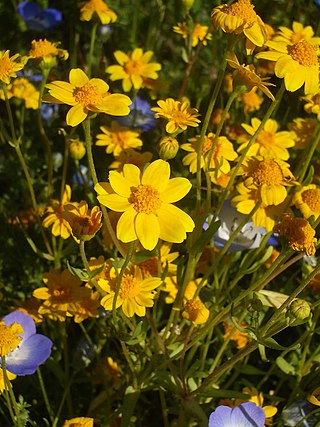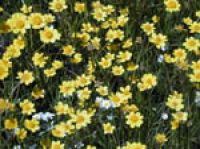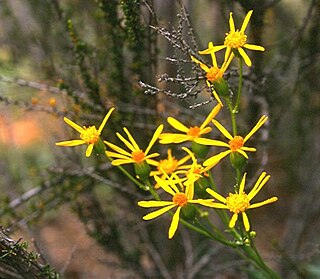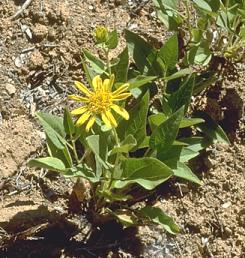
Lasthenia, commonly known as goldfields, is a genus of flowering plants family Asteraceae. The genus is named after Lasthenia of Mantinea, a cross-dressing female pupil of the ancient Greek philosopher Plato.

Lasthenia conjugens, commonly known as Contra Costa goldfields, is an endangered species of wildflower endemic to a limited range within the San Francisco Bay Area of the state of California, USA. Specifically this rare species occurs in Napa, Santa Barbara, Solano, Contra Costa, Santa Clara, Monterey and Alameda Counties. This annual herb typically flowers from March through June, and its colonies grow in vernal pool habitats at elevations not exceeding 100 meters above sea level. The Jepson Manual notes that the present distribution is limited to the deltaic Sacramento Valley, principally Napa and Solano Counties, but the historic range of L. conjugens is known to be significantly wider. In any case, historically the range has included parts of the North Coast, Sacramento Valley, and San Francisco Bay Area as well as the South Coast. Alternatively and less frequently this taxon has been referred to as Baeria fremontii var. conjugens.

Lasthenia californica is a species of flowering plant in the family Asteraceae known by the common name California goldfields. It is native to western North America.
Lasthenia chrysantha is a species of flowering plant in the family Asteraceae known by the common name alkalisink goldfields. It is endemic to the California Central Valley, where it grows in vernal pools and alkali flats.

Lasthenia coronaria is a species of flowering plant in the family Asteraceae known by the common name royal goldfields. It is native to California and Baja California, including Guadalupe Island.

Lasthenia ferrisiae is a species of flowering plant in the family Asteraceae known by the common name Ferris' goldfields. It is endemic to the California Central Valley, where it grows in vernal pools and alkali flats.

Lasthenia fremontii is a species of flowering plant in the family Asteraceae known by the common name Frémont's goldfields. It is endemic to the California Central Valley, where it grows in vernal pools and meadows.
Lasthenia glaberrima is a species of flowering plant in the family Asteraceae known by the common names smooth goldfields and rayless goldfields. It is native to western North America from British Columbia to California, where it grows in wet meadows and vernal pools.

Lasthenia glabrata is a North American species of flowering plant in the family Asteraceae known by the common names yellowray goldfields and yellow-rayed lasthenia. It is endemic to California, where it is a resident of vernal pools and other moist areas in a number of habitat types. It is widespread across much of the state, from San Diego County to Tehama County.
Lasthenia microglossa is a species of flowering plant in the family Asteraceae known by the common name smallray goldfields. It is endemic to California, where it grows in shady areas in a number of habitats.
Lasthenia minor is a species of flowering plant in the family Asteraceae known by the common name coastal goldfields. It is endemic to California, where it is a resident of coastal and inland grassland habitat.

Blennosperma bakeri is a rare species of flowering plant in the daisy family known by the common names Baker's stickyseed and Sonoma sunshine.
Lasthenia platycarpha is a species of flowering plant in the family Asteraceae known by the common name alkali goldfields. It is endemic to California, where it is known mainly from the Central Valley.

Laphamia inyoensis, known by the common names Inyo rockdaisy and Inyo laphamia, is a rare species of flowering plant in the aster family.

Packera ganderi is a rare species of flowering plant in the aster family known by the common name Gander's ragwort. It is endemic to southern California, where it is known from a few occurrences in San Diego and Riverside Counties.

Packera layneae, known by the common name Layne's ragwort and Layne's butterweed, is a rare species of flowering plant in the aster family.

Agnorhiza reticulata, known by the common name El Dorado County mule's ears, is a rare species of flowering plant found only in a small region of north-central California.

Deinandra bacigalupii is a rare species of flowering plant in the family Asteraceae, known by the common names Livermore tarplant and Livermore moonshine. It is endemic to Alameda County, California, and is only found within a half-mile of the city limits of Livermore, in the eastern portion of the Livermore Valley. The plant is considered endangered under the California Endangered Species Act, and there are only four known populations; a fifth was destroyed by a landscaping business in 2014. The majority is located on city property near the Springtown neighborhood. It grows in open areas with alkali soils, in alkali meadows and on the edges of alkali sinks, and appears to be restricted to a soil called Solano fine sandy loam. This plant was previously included within Deinandra increscens ssp. increscens, but it was separated and elevated to species level in 1999.
Heterotheca monarchensis is a rare species of flowering plant in the family Asteraceae known by the common names monarch goldenaster and sequoia false goldenaster. It is endemic to Fresno County, California, where it is known from only one location near Boyden Cave in the Kings River Canyon. It grows in the limestone cliffs of this Sierra Nevada river canyon, along with a few other rare local endemics. The plant was discovered in July, 1995, and described to science as a new species in 1996.

Deinandra conjugens is a rare species of flowering plant in the family Asteraceae known by the common names Otay tarplant and Otay tarweed. It is native to a small section of far northern Baja California in Mexico, its range extending north into San Diego County, California, in the United States. One isolated population has been reported from the hills east of Cayucos in San Luis Obispo County.














